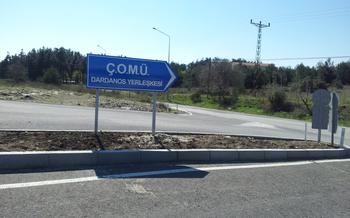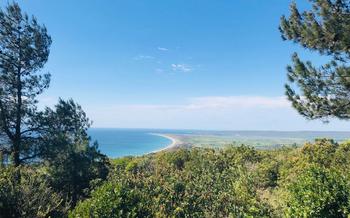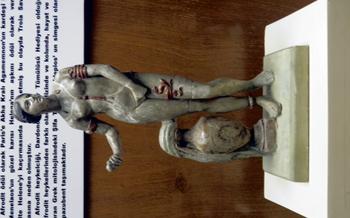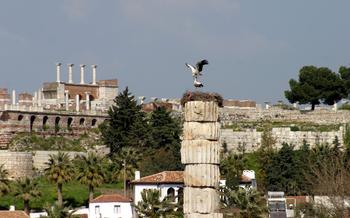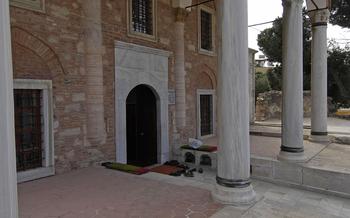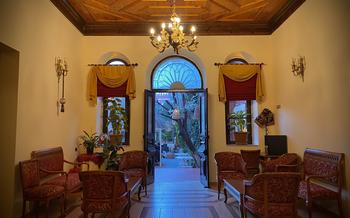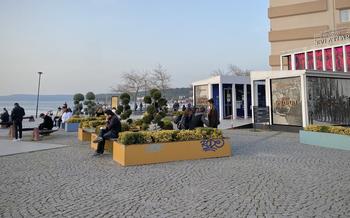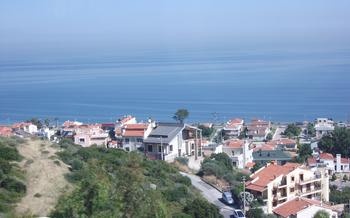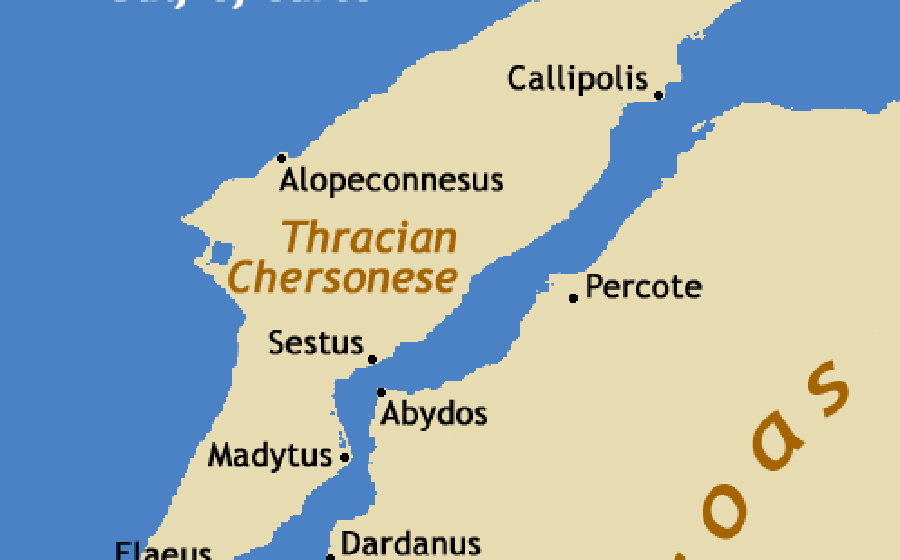
Ancient City of Abydos
- The Antiquity of Abydos
- The Walls of Abydos
- The Temple of Apollo Smintheus
- The Granaries of Abydos: Storing the Wealth of an Ancient City
- The Necropolis of Abydos
- The Museum of Abydos: A Treasure Trove of Ancient Discoveries
- The Natural Beauty of Abydos
- The Local Cuisine of Abydos
- The Warmth of the Locals
- Getting to Abydos
- Where to Stay in Abydos
- Things to Do Nearby
- The Best Time to Visit Abydos
- Safety Tips for Travelers
- Anecdote
The Antiquity of Abydos
Abydos, an ancient city in Turkey, boasts a rich history dating back to the Bronze Age. Archaeological excavations have revealed the city's glorious past, unearthing remnants of its once-thriving civilization. Legends and myths surround Abydos, including its connection to the legendary Trojan War, adding an aura of mystery and intrigue to this ancient site.
As I strolled through the ruins of Abydos, I couldn't help but feel a sense of awe and wonder. Here, history came alive as I traced the footsteps of those who had walked these streets millennia ago. The palpable energy of the past enveloped me, transporting me back in time to an era of heroes, battles, and divine interventions. Abydos, with its tangible history and mythical allure, is a true treasure trove for anyone seeking to delve into the depths of antiquity.
The Walls of Abydos
The ancient city of Abydos was once protected by a formidable system of walls, a testament to its strategic importance and resilience. These walls, constructed using large blocks of stone, stood tall and strong, forming an impenetrable barrier against invaders. The gateways, strategically positioned at various points along the walls, allowed for controlled access to the city.
The construction of the walls showcased the engineering prowess of the ancient Abydians. They employed advanced techniques, such as interlocking blocks and double-layered walls, to ensure the stability and durability of the fortifications. The walls also featured towers and turrets, providing vantage points for the city's defenders to keep watch and repel attacks.
Standing atop the walls of Abydos, one can't help but feel a sense of awe and wonder at the ingenuity of the ancient builders. The walls not only protected the city from physical threats but also served as a symbol of its strength and resilience. As you explore the ruins of Abydos, take a moment to marvel at these impressive fortifications and imagine the fierce battles that once took place here.
Anecdote:
During my visit to Abydos, I decided to explore the walls more closely. As I climbed the ancient steps, I couldn't help but feel a sense of excitement and anticipation. Reaching the top, I was greeted by a breathtaking panoramic view of the surrounding landscape. The walls stretched out in both directions, seemingly endless, and I could almost picture the city's defenders standing guard, ready to repel any threat. It was an exhilarating experience that transported me back in time, allowing me to connect with the ancient history of Abydos in a profound way.
The Temple of Apollo Smintheus
The Temple of Apollo Smintheus stands as a testament to the religious devotion and architectural prowess of ancient Abydos. Dedicated to the revered Greek god Apollo, this temple holds a prominent place in the city's history.
Constructed in the 7th century BC, the temple's design reflects the grandeur and sophistication of Hellenistic architecture. Its Doric columns, intricately carved with acanthus leaves, support a massive entablature adorned with exquisite friezes. The temple's interior, though now in ruins, once housed a colossal statue of Apollo, radiating divine presence throughout the sanctuary.
Beyond its architectural significance, the Temple of Apollo Smintheus carries deep historical and mythological associations. Apollo, known as Smintheus, was believed to have protected the city from a plague of mice, earning him the title "Mouse-Destroyer." This temple served as a center of worship and pilgrimage, where devotees sought Apollo's blessings and protection.
One summer afternoon, as I stood amidst the temple's ruins, I couldn't help but feel a palpable sense of awe. The crumbling walls and fallen columns whispered tales of ancient rituals and ceremonies that once took place within these sacred grounds. It was as if time stood still, allowing me to connect with the spiritual essence of this remarkable site.
The Temple of Apollo Smintheus, with its enduring legacy and captivating atmosphere, remains a must-visit destination for anyone seeking to delve into the rich tapestry of Abydos' past.
The Granaries of Abydos: Storing the Wealth of an Ancient City
In the ancient city of Abydos, nestled between the bustling streets and towering walls, lay a remarkable testament to the city's prosperity and foresight: the extensive granaries. These structures, designed with meticulous precision, served as the lifeblood of Abydos, ensuring that food and supplies were safely stored and readily available to sustain the city's growing population and its thriving trade.
Built using sturdy materials and employing advanced engineering techniques, the granaries showcased the ingenuity of Abydos' architects and builders. Constructed with thick stone walls and vaulted ceilings, these massive structures were designed to protect their precious contents from the elements, pests, and any potential threats.
Inside the granaries, row upon row of ceramic jars and amphorae lined the walls, filled to the brim with various grains, legumes, and other foodstuffs. These jars were carefully sealed and stacked, creating an organized and efficient storage system that allowed for easy access and inventory management.
The granaries played a pivotal role in sustaining Abydos' population. During times of plenty, the city's farmers and merchants filled the granaries to capacity, ensuring that the city had ample reserves to withstand leaner times or unexpected disruptions to trade routes.
Beyond their practical function, the granaries also held symbolic significance. They represented the wealth and prosperity of Abydos, a city that had mastered the art of agriculture and trade. The abundance stored within the granaries was a source of pride for the city's inhabitants and a symbol of their resilience and self-sufficiency.
Today, the granaries of Abydos stand as a testament to the city's rich history and its enduring legacy. While the bustling trade routes and vibrant markets of the past may be gone, the granaries remain as silent witnesses to the ingenuity and foresight of the people who once called Abydos home.
The Necropolis of Abydos
A Journey into the Past:
Stepping beyond the ancient city walls of Abydos, one encounters a vast expanse of land marked by countless mounds and stone markers - the necropolis, or cemetery, of this ancient city. Here, beneath the watchful eyes of the gods, lie the remains of Abydos' inhabitants, their stories etched in the stones that mark their final resting places.
The necropolis is a treasure trove of archaeological discoveries, revealing the diverse burial practices and customs of Abydos' people. From simple pit graves to elaborate stone-lined tombs, each burial site offers a glimpse into the lives and beliefs of those who once called this city home.
Among the most fascinating tombs in the necropolis is the Painted Tomb, adorned with vivid frescoes depicting scenes from daily life and mythology. These vibrant paintings offer a rare and intimate glimpse into the beliefs and values of Abydos' ancient society.
As you wander through the necropolis, take a moment to reflect on the lives of those who once walked these same paths. Imagine the mourners who gathered here to bid farewell to their loved ones, the rituals and ceremonies that accompanied each burial, and the stories that each tomb could tell if only it could speak.
Anecdote:
During my visit to the necropolis, I stumbled upon a particularly intriguing tomb. Its entrance was partially hidden by overgrown vegetation, and as I peered inside, I noticed a small, intricately carved stone tablet. Curiosity piqued, I carefully removed the tablet and found myself staring at a beautifully preserved depiction of a family. The father, mother, and child were all smiling, their faces radiating love and contentment.
I could not help but wonder about the story behind this family. Were they wealthy landowners? Simple farmers? Perhaps they were merchants who had traveled far and wide, bringing prosperity to their city. Whatever their story, I felt a deep connection to these people who had lived so long ago, and their memory would stay with me long after I left Abydos.
The Museum of Abydos: A Treasure Trove of Ancient Discoveries
Within the heart of Abydos lies a treasure trove of ancient artifacts and historical wonders: the Museum of Abydos. This remarkable institution houses a diverse collection of relics unearthed from the city's rich past, offering visitors a glimpse into the lives and culture of its former inhabitants.
As you step through the doors of the museum, you are greeted by an array of pottery, sculptures, and inscriptions that narrate the story of Abydos. Among the highlights of the collection is a stunning array of pottery, adorned with intricate designs and vibrant colors that have remained remarkably preserved over time. These ceramic masterpieces provide a glimpse into the artistic prowess and craftsmanship of Abydos' ancient artisans.
Equally captivating are the numerous sculptures that grace the museum's halls. Carved from stone or cast in bronze, these statues depict gods, goddesses, and historical figures with remarkable detail and realism. They offer a tangible connection to the religious beliefs and cultural practices of ancient Abydos.
Inscriptions, etched on stone tablets or fragments of pottery, hold the key to unlocking the city's written history. These inscriptions, often in ancient Greek or Latin, provide valuable insights into the political, economic, and social structures of Abydos. They document the names of rulers, record religious rituals, and shed light on the daily lives of the city's inhabitants.
The Museum of Abydos is not merely a repository of ancient artifacts but also a place where history comes alive. Through interactive exhibits and educational displays, the museum brings the past to life, allowing visitors to experience the grandeur and significance of Abydos in a truly immersive way.
Anecdote:
During my visit to the Museum of Abydos, I was particularly drawn to a small, unassuming artifact displayed in a glass case. It was a bronze figurine of a horse, exquisitely crafted with intricate details that captured the animal's grace and power. As I gazed upon this ancient masterpiece, I couldn't help but imagine the hands that had created it centuries ago and the stories it could tell. It was a tangible reminder of the artistry and craftsmanship that flourished in Abydos, a city that continues to reveal its secrets to this day.
The Natural Beauty of Abydos
Nestled amidst the breathtaking landscapes of Çanakkale, Abydos boasts a harmonious blend of natural wonders. The city's crown jewel is undoubtedly the Dardanelles Strait, a mesmerizing waterway that separates Europe from Asia. Whether you're a seasoned hiker or simply seeking a tranquil escape, the Dardanelles offers a plethora of opportunities for outdoor enthusiasts. Embark on a scenic hike along the winding trails that hug the coastline, immersing yourself in the symphony of nature's whispers. As you traverse these paths, keep your eyes peeled for an array of bird species that call this region their home. The skies above Abydos are alive with the vibrant hues and melodious songs of these feathered wonders.
For those seeking a refreshing dip, the crystal-clear waters of the Dardanelles beckon. Plunge into the invigorating embrace of the sea and let your worries melt away as you bask in the sun's golden glow. The coastal areas surrounding Abydos are also home to a diverse array of flora and fauna, adding to the city's allure. Discover hidden groves of olive trees, their silvery leaves shimmering in the gentle breeze, or marvel at the vibrant tapestry of wildflowers that paint the landscape with a kaleidoscope of colors. Abydos invites you to embrace the beauty of nature, whether you're hiking through its verdant hills, gliding across the shimmering waters, or simply basking in the tranquility of its natural surroundings.
The Local Cuisine of Abydos
The culinary scene in Abydos is a delightful blend of traditional Turkish flavors and Mediterranean influences. The city offers a diverse range of dishes to tantalize your taste buds, from savory kebabs and gözleme to fresh seafood and meze platters.
One must-try dish in Abydos is iskender kebab, a flavorful combination of thinly sliced döner meat, crispy pide bread, tomato sauce, and melted butter. The Çanakkale köfte, a specialty of the region, is another must-have. These delicious meatballs are made with a mixture of ground beef, spices, and herbs, and are often served with a side of rice or bulgur.
For seafood lovers, Abydos offers an array of freshly caught fish and shellfish. The grilled octopus is a popular choice, as is the levrek, a type of sea bass that is often cooked with lemon and herbs.
No meal in Abydos is complete without sampling the meze platters. These small plates feature a variety of appetizers, such as hummus, baba ganoush, ezme, and cacık. They are perfect for sharing and make a great way to start your meal.
For a truly authentic dining experience, head to one of the many local restaurants or eateries in Abydos. These establishments often have a warm and inviting atmosphere, and the staff is always happy to recommend dishes and provide friendly service.
In one memorable dining experience, I stumbled upon a small family-run restaurant tucked away in a side street. The owner greeted me warmly and recommended the guvec, a traditional Turkish casserole made with lamb, vegetables, and spices. The dish was slow-cooked in a clay pot, and the flavors were simply divine. I savored every bite, feeling grateful for the opportunity to experience such authentic and delicious Turkish cuisine.
The Warmth of the Locals
In Abydos, the warmth and hospitality of the locals are as captivating as the ancient ruins themselves. The people of Abydos are renowned for their welcoming nature, always ready to greet visitors with a smile and a helping hand. Their generosity and kindness are evident in their eagerness to share stories about their city, its history, and their way of life.
One unforgettable experience that highlighted the warmth of the locals occurred during a chance encounter with an elderly woman named Ayşe Teyze. As I wandered through the narrow streets of the city, I stumbled upon a small, unassuming bakery that caught my attention. Curiosity piqued, I stepped inside and was greeted by the sweet aroma of freshly baked goods. Ayşe Teyze, the owner of the bakery, welcomed me with a warm smile and offered me a taste of her delicious pastries. As we sat and chatted, she shared stories of her childhood in Abydos, her family's history in the city, and her passion for baking. Her warmth and kindness left a lasting impression, making me feel like I was part of the community rather than just a visitor.
The people of Abydos take pride in their city and are eager to share its beauty and history with others. Whether it's a friendly conversation with a shopkeeper, a helping hand from a passerby, or an invitation to join a local celebration, the warmth of the locals in Abydos is sure to leave an enduring mark on your journey.
Getting to Abydos
Reaching Abydos is a journey that blends the allure of history with the ease of modern transportation. To arrive in this ancient city, you can take advantage of Turkey's well-connected transportation network. From major cities like Istanbul, Ankara, or Izmir, hop on a comfortable bus or train that will take you on a scenic ride through the Turkish countryside. As you approach Abydos, the landscape transforms, revealing glimpses of the Dardanelles Strait and the silhouette of the city's iconic walls.
For those who prefer air travel, the nearest airport is Çanakkale Airport (CKZ), located just 12 kilometers from Abydos. From there, you can take a short taxi ride or hop on a local bus to reach the city center. Alternatively, you can fly to Istanbul and take a connecting flight to Çanakkale, which offers more frequent flight options.
Once in Abydos, the best way to explore the city is on foot or by bicycle. The compact size of the ancient city allows you to easily navigate its streets and discover its hidden gems at your own pace. Embrace the opportunity to get lost in the labyrinthine alleys, stumble upon charming cafes, and engage with the friendly locals who are always ready to share stories about their beloved city.
Anecdote
During my first visit to Abydos, I arrived by bus from Istanbul. As the bus approached the city, I couldn't help but feel a sense of anticipation. The landscape transformed from bustling urban scenery to tranquil countryside vistas, and the Dardanelles Strait shimmered in the distance. The bus driver, noticing my excitement, pointed out the ancient walls of Abydos peeking over the horizon.
As we entered the city, I was struck by the harmonious blend of history and modernity. While the ancient ruins stood as testaments to Abydos' glorious past, the streets were lined with vibrant shops, cafes, and restaurants. The locals greeted me with warm smiles and helpful directions, making me feel instantly welcomed in this historic city.
Where to Stay in Abydos
Abydos offers a range of accommodation options to suit different budgets and preferences. From charming guesthouses to modern hotels, you'll find a place to rest and recharge during your exploration of this ancient city.
For a truly immersive experience, consider staying in a traditional Turkish guesthouse. These guesthouses often feature beautiful architecture, comfortable rooms, and warm hospitality. You'll have the chance to interact with local families and learn about their way of life.
If you prefer a more modern experience, there are several hotels in Abydos that offer contemporary amenities and सुविधाएं। These hotels are typically located close to the city center, making it easy to explore the main attractions.
It's advisable to book your accommodation in advance, especially if you're visiting during the peak tourist season. This will ensure that you have a comfortable place to stay and avoid any last-minute surprises.
Anecdote:
During my visit to Abydos, I had the pleasure of staying in a traditional Turkish guesthouse. The guesthouse was run by a lovely family who welcomed me with open arms. They served me delicious homemade meals and shared stories about their lives and the history of Abydos. I felt like I was part of their family and had a truly authentic experience.
Things to Do Nearby
Beyond the captivating wonders of Abydos itself, the surrounding region beckons with an array of intriguing attractions. Troy, the legendary city immortalized in Homer's epic tale, lies a mere 30 kilometers away, inviting history buffs to delve into the myths and realities of this ancient metropolis. Bozcaada, an enchanting island just off the coast, offers a serene escape amidst picturesque landscapes and charming villages. Nature enthusiasts can embark on a scenic hike through the Kaz Mountains National Park, marveling at its diverse flora and fauna. For a taste of local culture, venture to the vibrant city of Çanakkale, where bustling markets, historic landmarks, and delectable cuisine await.
The Best Time to Visit Abydos
When to Go:
The best time to visit Abydos is during the shoulder seasons, spring (April-May) and autumn (September-October). During these months, the weather is pleasant with warm, sunny days and cool nights, making it ideal for exploring the ancient city and its surroundings. The crowds are also smaller, allowing you to enjoy a more peaceful and intimate experience.
Summer Heat:
Summer months (June-August) can be hot and humid, with temperatures often reaching the mid-30s Celsius. While the heat can be oppressive, it's still possible to visit Abydos during this time if you take precautions such as staying hydrated, wearing loose-fitting clothing, and avoiding the midday sun.
Winter Charm:
Winter (November-March) brings cooler temperatures and occasional rain, but it's still a great time to visit Abydos if you're looking for a more solitary experience. The city takes on a different charm in the winter, with a peaceful tranquility that allows you to connect with its ancient history in a deeper way.
Anecdote:
I visited Abydos in early October, during the shoulder season, and it was the perfect time to explore. The weather was warm and sunny, with a gentle breeze that made walking around the ancient city a pleasure. The crowds were minimal, allowing me to take my time and soak in the atmosphere without feeling rushed. It was the ideal setting to contemplate the history and legacy of this remarkable place.
Safety Tips for Travelers
Abydos is generally a safe city for travelers, but as with any destination, it's essential to take precautions to ensure your safety. Be aware of your surroundings, especially in crowded areas, and keep your valuables secure. Avoid walking alone at night, and if you're unsure about an area, ask a local for directions or advice.
Anecdote
During my visit to Abydos, I had an experience that reminded me of the importance of staying vigilant. I was exploring the city alone when I noticed a man following me. At first, I thought it was just a coincidence, but as I continued walking, he kept following me. I started to feel uneasy, so I decided to cross the street and walk in the opposite direction. The man followed me across the street and continued to follow me.
At this point, I was sure that the man was following me intentionally. I started to walk faster, and he followed me faster. I realized that I needed to do something, so I stopped and turned to face the man. I asked him what he wanted, and he said he was just trying to help me find my way. I told him that I didn't need his help, and I asked him to leave me alone.
The man hesitated for a moment, but then he turned and walked away. I was relieved that the situation had ended peacefully, but it was a reminder that even in a safe city like Abydos, it's important to be aware of your surroundings and to take precautions to protect yourself.
